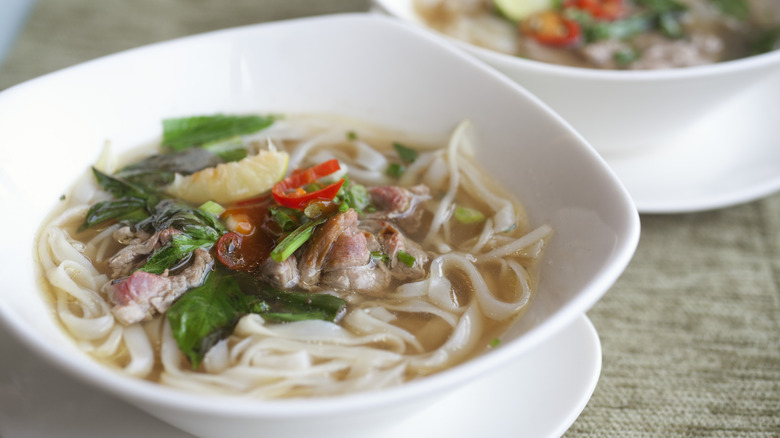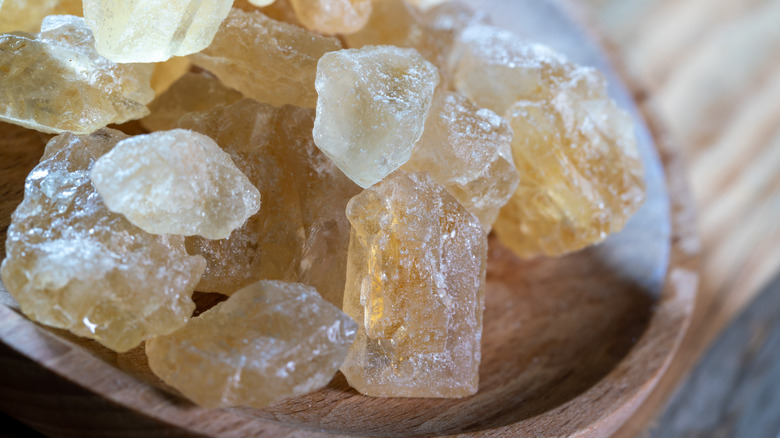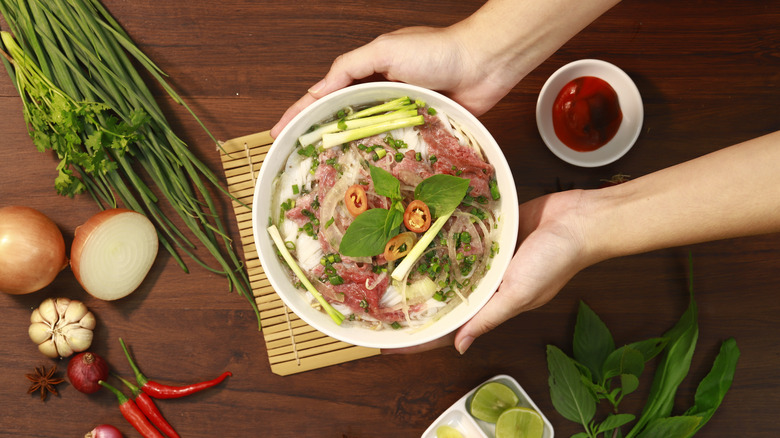Yellow Rock Sugar Is The Lesser-Known Ingredient Your Pho Needs
Vietnamese cuisine draws a great deal of inspiration from China. As such, every Vietnamese chef strives to represent all five essential flavors: sweetness, bitterness, sourness, spiciness, and savoriness — also known as "ngũ vị" or "the five tastes." Phở is no exception to this rule, and it's precisely because of this balance that the dish is so incredibly delicious.
If you look closely, you'll notice that all the ingredients in a bowl of phở — including the broth, noodles, meat, condiments, and fresh herbs — contribute to these five essential tastes. But let's focus on just one of these five flavors for today: sweetness. In phở, sweetness comes from natural sugars in aromatics like caramelized onions and shallots. Additionally, the broth gets a touch of sweetness from simmering meaty bones and marrow in the pot, known in Vietnamese as "ngọt thịt" or "meaty sweetness."
This sweetness, which is considered by the Vietnamese to be different from sugary sweetness, arises from the complex sugars and sweet-tasting organic compounds in the cow's muscles, per a 2011 study published in the Asian Journal of Animal and Veterinary Advances. But at this stage, the broth is only subtly sweet. To amp up the flavor, good old sugar crystals are added. While many Western recipes use refined sugar, authentic phở uses a special type called yellow rock sugar — and that's what sets the "traditional" phở apart from all others.
What is yellow rock sugar?
Yellow rock sugar, known as "đường phèn" in Vietnamese, is a unique form of unprocessed sugar made from sugar cane juice and palm sap. Unlike the typical granulated sugar you find in most grocery stores, this type of sugar is allowed to condense and crystallize into large lumps, hence its name: "rock sugar." What sets rock sugar apart is its milder sweetness compared to granulated sugar.
You need to use twice the amount of rock sugar by weight to achieve the same level of sweetness. This precise control over sweetness is ideal for fine-tuning your phở broth. Additionally, the sweetness provided by rock sugar has a distinct character separate from granulated sugar. In Vietnamese, rock sugar is described as "ngọt thanh," meaning "delicately sweet," while regular granulated sugar is called "ngọt sắc," or "sharply sweet."
Since we're making a broth and not a dessert like tong sui, the gentle sweetness of rock sugar is what we're aiming for. It should add just a hint of sweetness without overpowering the flavors. When you're picking rock sugar, you'll find two colors: white and yellow. Most Vietnamese chefs prefer the yellow type. The caramel-like hue comes from some extra molasses that remains in the crystals, which supposedly gives the sugar a slightly richer and more complex flavor compared to the white varietal.
How to incorporate yellow rock sugar into your phở
To make phở broth, fill a stockpot with water and add meaty bones, marrows, and briskets that have been blanched prior. Then, allow this mixture to simmer for about an hour to extract all the meaty flavors and create a basic broth. After skimming the foam and fat floating at the top and adding roasted aromatics and spices, you can go ahead and throw in the yellow rock sugar, along with other seasonings like salt, fish sauce, and MSG.
The exact amount will depend on how much broth you're making. As a general rule, you'll want about 2 tablespoons of yellow rock sugar for every 1.5 liters of broth. Seasoned chefs (ha!) may taste a small sample of the broth to check the seasoning and make adjustments if necessary. If it tastes just right to you, let it simmer for an extra three to five minutes, and your broth is good to go. You can keep it warm on the stove until other components of the phở are finished. All that's left to do is ladle out the broth and serve!


